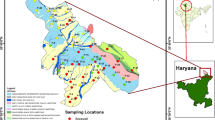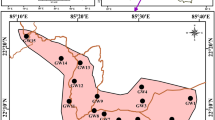Abstract
A study of the hydrogeochemical processes in the national capital territory of India was carried out with the objective of identifying the geochemical processes and their relation with groundwater quality as well as to get an insight into the hydrochemical evalution of groundwater. Salinity and nitrate contamination are the two major problems in the area, which is alarming considering the use of this water for drinking. Various graphical plots and statistical analyses have been carried out using chemical data to deduce a hydrochemical evaluation of the aquifer system based on the ionic constituents, water types, hydrochemical facies and factors controlling groundwater quality. The prevailing hydrochemical processes operating here are simple dissolution, mixing, weathering of carbonate minerals, locally known as ‘kankar’, and of silicate, ion exchange, and surface water interaction. Limited reverse ion exchange has been noticed in a few parts of the study area especially in post-monsoon periods. Periodic seasonal switch-over has been clearly noticed in these hydrogeochemical processes that control groundwater quality of the area. The number of factors that control the overall mineralization and water quality of Delhi vary from season to season. In pre-monsoon, there are four factors while in post-monsoon it increases to five. The study highlights the descriptive capabilities of conventional and multivariate techniques as effective tools in groundwater evaluation.
















Similar content being viewed by others
References
APHA (1995) Standard methods for the examinations of water and waste water, 17th edn. American Public Health Association, Washington
Ashley RP, Lloyd JW (1978) An example of the use of factor analysis and cluster analysis in groundwater chemistry interpretation. J Hydrol 39:355–364
Back W (1961) Techniques for mapping of hydrochemical facies. US Geol Surv Prof Pap 424-D:380–382
Ballukraya PN, Ravi R (1999) Characterization of groundwater in the unconfined aquifer of Chennai City, India. J Geol Soc India 54:1–11
Bartarya SK (1993) Hydrochemistry and rock weathering in a sub-tropical lesser Himalayan river basin in Kumaun, India. J Hydrol 146:149–174
Berner-Kay E, Berner RA (1987) The global water cycle, geochemistry and environment. Prentice-Hall, Englewood Cliffs, 396 p
Catroll D (1962) Rain water as a chemical agent for geological processes—a review. USGS Water Supply 1533:18–20
Cattel RB (1965) Factor analysis: introduction to essentials. Biometrics 21:190–125
Cerling TE, Pederson BL, Damm KLV (1989) Sodium–calcium ion exchange in the weathering of shales: implications for global weathering budgets. Geology 17:552–554
CGWB (2003) Groundwater in Delhi—improving the sustainability through rain water harvesting. Report
CPCB (2001) Water quality status of lakes and reservoirs in Delhi. Report
Das Brijraj K, Kakar YP, Moser H, Stichler W (1988) Deuterium and oxygen-18 studies in groundwater of the Delhi area, India. J Hydrol 98:133–146
Datta PS, Tyagi SK (1996) Major ion chemistry of groundwater in Delhi area: chemical weathering processes and groundwater flow regime. J Geol Soc India 47:179–188
Datta PS, Bhattacharya SK, Tyagi SK (1996) 18O studies on recharge of phreatic aquifers and groundwater flow-paths of mixing in the Delhi area. J Hydrol 176:25–36
Datta PS, Deb DL, Tyagi SK (1997) Assessment of groundwater contamination from fertilizers in the Delhi area based on 18O, NO −3 and K+ composition. J Contam Hydrol 27:249–262
Davis JC (1986) Statistics and data analysis in geology. Wiley, New York
Davis SN, DeWiest RJM (1967) Hydrogeology. Wiley, New York
Dawdy DR, Feth JH (1967) Application of factor analysis in the study of chemistry of groundwater quality, Mojave River Valley, California. Water Resour Res 3:505–510
Domenico PA (1972) Concepts and models in groundwater hydrology. McGraw-Hill, New York
Durov SA (1948) Natural waters and graphical representation of their composition. Dokl Akad Nauk USSR 59:87–90
Durum WH, Haffty J (1963) Implications of the minor element content of some major streams of the world. Geochim Cosmochim Acta 27:1
Edmond JM, Palwer MR, Measures CF, Grant B, Stallard RF (1995) The fluvial geochemistry and denudation rate of the Guayana Shield in Venezuela. Geochim Coscochim Acta 59:3301–3323
Fisher RS, Mulican WF III (1997) Hydrochemical evolution of sodium–sulphate and sodium–chloride groundwater beneath the Northern Chihuahuan desert, Trans-Pecos, Texas, USA. Hydrogeol J 10(4):455–474
Freeze RA, Cherry JA (1979) Groundwater. Prentice-Hall, Englewood Cliffs, p 604
Guler C, Thyne GD, McCray JE, Turner AK (2002) Evaluation of graphical and multivariate statistical method for classification of water chemistry data. Hydrogeol J 10(4):455–474
Gupta SK, Deshpande RD (2004) Water for India in 2050: first-order assessment of available options. Curr Sci 86:1216–1223
Handa BK (1988) Content of potassium in groundwater in India. Fertil News 33(11):15–27
Hem JD (1989) Study and interpretation of the chemical characteristics of natural water, 3rd edn. United States Geological Survey Water Supply Paper 2254
Huh Y, Tsoi MY, Zaitiser A, Edward JN (1998) The fluvial geochemistry of the river of Eastern Siberia. I. Tributaries of Lena River draining the sedimentation platform of the Siberia Craton. Geochim Cosmochim Acta 62:1657–1676
Jacks G (1973) Chemistry of groundwater in a district in Southern India. J Hydrol 18:185–200
Jankowski J, Acworth RI (1997) Impact of depris-flow deposits on hydrogeochemical processes and the development of dryland salinity in the Yass River catchment, New South Wales, Australia. Hydrogeol J 5(4):71–88
Klovan JE (1975) R-mode and Q-mode factor analysis. In: McCammon RB (ed) Concepts in geostatistics. Springer, Berlin Heidelberg New York, p 168
Lloyd JW, Heathcode JA (1985) Natural inorganic hydrochemistry in relation to groundwater. Oxford University Press, New York
Matthess G (1982) The properties of groundwater. Wiley, New York, p 498
Maya AL, Loucks MD (1995) Solute and isotopic geochemistry and groundwater flow in the Central Wasatch Range, Utah. J Hydrol 172:31–59
Meybeck M (1987) Global chemical weathering of surficial rocks estimated from river dissolved loads. Am J Sci 287:401–428
Paliwal KV, Yadav BL (1976) Irrigation water quality and crop management in U.T. of Delhi. Water Technology Centre, IARI, New Delhi, Res Bull 9:1–45
Ramesam V (1982) Geochemistry of groundwater from a typical hard rock terrain. J Geol Soc India 23:201–204
Sami K (1992) Recharge mechanisms and geochemical processes in a semi-arid sedimentary basin, Eastern Cape, South Africa. J Hydrol 139:27–48
Schoeller (1965) Hydrodynamique lans lekarst (ecoulemented emmagusinement). Actes Colloques Doubronik, I, AIHS et UNESCO, pp 3–20
Schuh WM, Klinekebiel DL, Gardner JC, Meyar RF (1997) Tracer and nitrate movements to groundwater in the Norruem Great Plains. J Environ Qual 26:1335–1347
Seth NN, Khanna SP (1969) A note on groundwater conditions in the Delhi area. Geological Survey of India Miscellaneous Publication No. 14, Part III, pp 101–110
Sett DN (1964) Groundwater geology of the Delhi region. Bull Geol Surv India Series B 16:l–35
Sharma B, Kumar M, Ramanathan AL (2004) Impact of surface water on the groundwater quality in and around Nazafgarh Drain, Delhi. In: Ramesh R, Ramachandran S (eds) Freshwater management. Capital Publication Co., Delhi, pp 70–86
Stallard RF, Edmond JM (1983) Geochemistry of Amazon, the influence of geology and weathering environment on the dissolved load. J Geophys Res 88:9671–9688
Subramanian V, Saxena K (1983) Hydrogeochemistry of groundwater in the Delhi region of India, relation of water quality and quantity. In: Proceedings of the Hamberg symposium IAHS publication no. 146, pp 307–316
Toth J (1984) The role of regional gravity flow in the chemical and thermal evolution of groundwater. In: Proceedings of the 1st Canadian/American conference on hydrogeology, Banff, Alberta, June 1984
Wadia DN (1981) Geology of India. Tata McGraw-Hill, New Delhi, p 508
Wallick EI, Toth J (1976) Methods of regional groundwater flow analysis with suggestions for the use of environmental isotope and hydrochemical data in groundwater hydrology. IAEA, Vienna, pp 37–64
WHO (1984) Guidelines for drinking water quality-II. Environmental Health Criteria, 5. World Health Organisation, Geneva, p 333
Acknowledgments
Author (MK) thanks Council of Scientific and Industrial Research (India) for financial grant through a junior research fellowship. The authors also thank the reviewer for his kind suggestions and the Director, National Institute of Hydrology, Roorkee for allowing to use the analysis facility in his department. We thank Department of Science and Technology (DST), India for partial funding in form of research projects. We would also like to thank Dr Roger Herbert Jr of Uppsala University, Sweden, for his useful directions.
Author information
Authors and Affiliations
Corresponding author
Rights and permissions
About this article
Cite this article
Kumar, M., Ramanathan, A., Rao, M.S. et al. Identification and evaluation of hydrogeochemical processes in the groundwater environment of Delhi, India. Environ Geol 50, 1025–1039 (2006). https://doi.org/10.1007/s00254-006-0275-4
Received:
Accepted:
Published:
Issue Date:
DOI: https://doi.org/10.1007/s00254-006-0275-4




